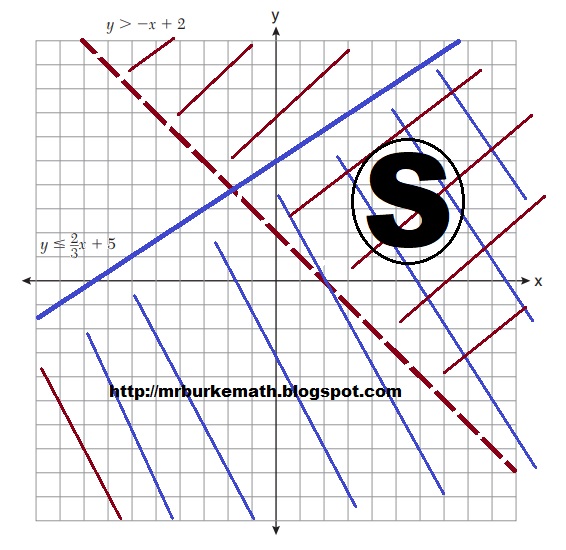Now that I'm caught up with the current New York State Regents exams, I'm revisiting some older ones. The Integrated Algebra Regents covered most of the same material as the current Algebra Regents, with a few differences.
More Regents problems.
Integrated Algebra Regents, January 2011
Part I: Each correct answer will receive 2 credits.
26. What is the result when 2x2 + 3xy − 6 is subtracted from x2 − 7xy + 2?
1) -x2 - 10xy + 8
2) x2 + 10xy − 8
3) -x2 - 4xy − 4
4) x2 - 3xy − 4
Answer: 1) -x2 - 10xy + 8
The "from" goes on top and the other expression goes on the bottom.
x2 − 7xy + 2
2x2 + 3xy − 6
-x2 - 10xy + 8
This is Choice (1).
Watch your signs when subtracting negatives.
27. What is an equation of the axis of symmetry of the parabola represented
by y = −x2 + 6x − 4?
1) x = 3
2) y = 3
3) x = 6
4) y = 6
Answer: 1) x = 3
The Axis of Symmetry is ALWAYS x = a number. Eliminate Choices (2) and (4).
The formula is x = -b/(2a), where a = -1 and b = 6.
So x = -(6)/(2(-1)) = -6/-2 = 3, which is Choice (1).
They didn't even try to trick you with x = -3 in case you forgot a sign.
28. Which equation has roots of −3 and 5?
1) x2 + 2x - 15 = 0
2) x2 - 2x - 15 = 0
3) x2 + 2x + 15 = 0
4) x2 -+ 2x + 15 = 0
Answer: 2) x2 - 2x - 15 = 0
If the roots are -3 and 5, then multiply (x + 3)(x - 5).
(x + 3)(x - 5) = x2 - 5x + 3x - 15 = x2 - 2x - 15, which is Choice (2).
29. A spinner that is equally divided into eight numbered sectors is spun 20 times. The table below shows the number of times the arrow landed in each numbered sector.
Based on the table, what is the empirical probability that the spinner
will land on a prime number on the next spin?
1) 9/20
2) 11/20
3) 12/20
4) 14/20
Answer: 3) 12/20
The prime numbers on the spinner are 2, 3, 5, and 7. (1, 4, 6, and 8 are NOT prime numbers.) Those four numbers appeared 3, 2, 4, and 3 times, respectively.
The sum of 3 + 2 + 4 + 3 = 12, so the empirical probability is 12/20, which is Choice (3).
30. Which expression represents (x2 - x - 6) / (x2 − 5x + 6)
in simplest form?
1) (x + 2) / (x - 2)
2) (-x - 6) / (-5x + 6)
3) 1/5
4) 1
Answer: 1) (x + 2) / (x - 2)
Since the numerator does NOT match the denominator, it should be obvious that the answer is NOT 1. Eliminate Choice (4).
Factor both the numerator and the denominator into two binomials. Cancel out the common pairs which make 1.
(x2 - x - 6) factors into (x - 3)(x + 2).
(x2 − 5x + 6) factors into (x - 3)(x - 2)
(x - 3)/(x - 3) = 1
So the fraction reduces to (x + 2)/(x - 2), which is Choice (1).
More to come. Comments and questions welcome.
More Regents problems.
I also write Fiction!
You can now preorder Devilish And Divine, edited by John L. French and Danielle Ackley-McPhail, which contains (among many, many others) three stories by me, Christopher J. Burke about those above us and from down below.
Preorder the softcover or ebook at Amazon.
Also, check out In A Flash 2020, by Christopher J. Burke for 20 great flash fiction stories, perfectly sized for your train rides.
Available in softcover or ebook at Amazon.
If you enjoy it, please consider leaving a rating or review on Amazon or on Good Reads.
|
 |
 |
























